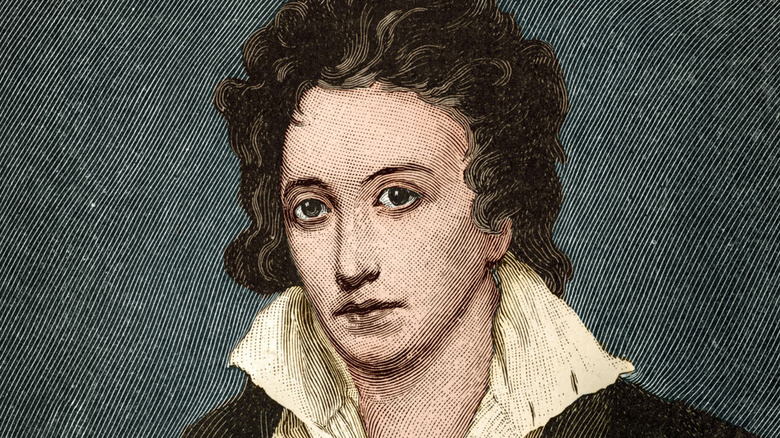Mary Shelley Kept A Macabre Memento Of Her Husband After His Death
Writer Mary Shelley is perhaps most well known as the author of "Frankenstein," a novel that continues to evoke the imagination of readers 200 years after its publication (via Biography). However, Bustle writes that she is also considered to be one of history's greatest goths. Born as Mary Wollstonecraft Godwin in 1797, her mother was none other than famed feminist writer Mary Wollstonecraft. The Museum of Idaho explains that Shelley had a life full of loss. Per JSTOR Daily, her mother died shortly after her birth due to a disease known as puerperal fever. As a result, Shelley spent much of her childhood visiting her mother's grave.
Her father, William Goodwin, later married Mary Jane Clairmont, with whom Mary Godwin did not get along. The future author often spent her time reading and daydreaming in the cemetery to escape her chaotic home life. Although she did not go to school, she was self educated and published her first poem in 1807 (per Biography). The Guardian reports that she was only 18 when she first conceived the idea of "Frankenstein."
Published in 1818, Shelley was at this point already married to Percy Shelley, a renowned romantic poet. Rosenbach states that the pair met in May, 1814 when Percy was one of her father's students. Her father, however, did not approve of their courtship, but there was little to be done to stop it.
The romance between Mary Shelley and Percy Shelley
When Mary and Percy began their relationship, Biography explains, he was already married to a woman named Harriet. Moreover, they had a child and another one on the way. According to JSTOR Daily, Mary was only 16 and Percy 22 at the time. Despite this, the couple fell hard for each other and spent time at Percy's favorite place: the cemetery. In fact, Snopes writes that many believe that Mary and Percy first consummated their relationship at her mother's grave. Although there is no way to truly prove this, historians do agree that the pair first declared their love for each other at the site.
Shortly after, Rosenbach reports, Mary and Percy ran off and traversed through Europe together. Mary's father subsequently disowned her. Per another article from Biography, their relationship was anything but ideal. They had little money and their first child together died in 1815, a few weeks after her birth. Mary also mourned the death of her half-sister (per Museum of Idaho).
However, there is a silver lining to their European excursion, as this is where it's believed that Mary first began working on "Frankenstein." After a rainy day sequestered Mary and a group of friends (including Lord Byron), they decided to pass the time by telling each other ghost stories, and "Frankenstein" was born. In 1816 tragedy struck again when Percy's wife committed suicide (via Rosenbach). Mary and Percy made things official and married weeks later, per Biography.
Percy Shelley's tragic death
According to Biography, Mary and Percy had three more children together. Only their son, born in 1819, and also named Percy, survived into adulthood. But fate had more grief in store for Mary. In 1822, Percy went on a sailing trip and never returned home (via another article from Biography). Snopes reports that the 29-year-old drowned near the Gulf of Spezia in Italy. Although many believe that Percy's death was an accident, others think he was murdered for political reasons.
Whatever the case, his death made Mary, then 24, a widow and single mother. Percy's body was cremated by a friend, and to the man's surprise, Percy's heart remained intact.The Museum of Idaho writes that Mary quickly claimed ownership of the heart. Snopes notes that it's unknown exactly why the heart did not burn. Some note that it was most likely already calcified due to a previous case of tuberculosis. Mary reportedly kept the heart in a box on her desk.
When she died in 1851 from brain cancer (per Biography), her son, Percy Florence Shelley, found the heart wrapped in silk and his father's poetry. The McCarter Theatre Center states that her deceased children's hair was also found in the desk. Although this might seem strange, the BBC explains that it was custom to keep mementos from the dead, including hair, during the Victorian era.


